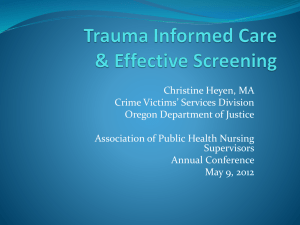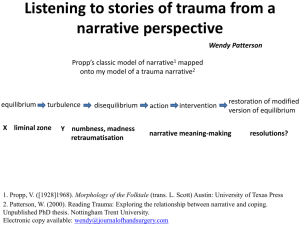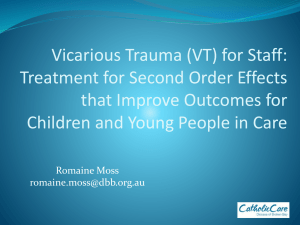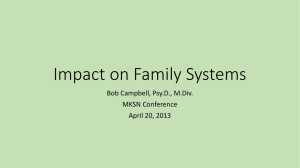Presented by - Florida Alcohol and Drug Abuse Association
advertisement
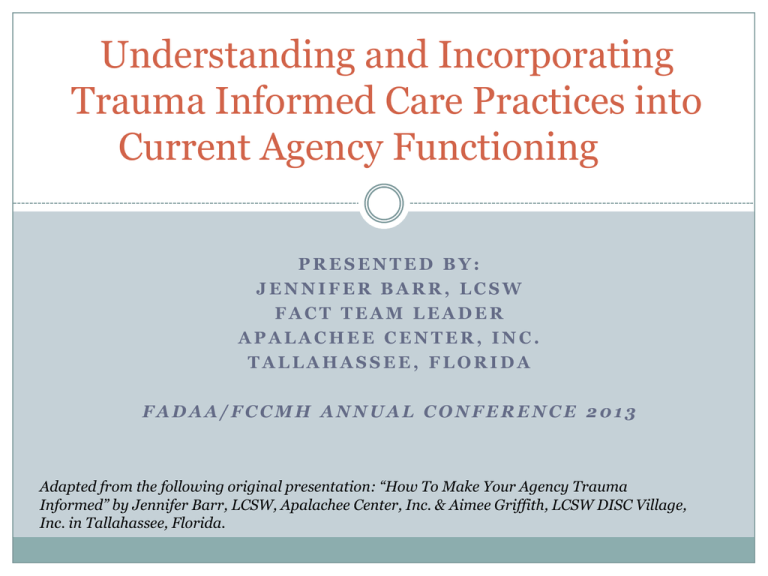
Understanding and Incorporating Trauma Informed Care Practices into Current Agency Functioning PRESENTED BY: JENNIFER BARR, LCSW FACT TEAM LEADER APALACHEE CENTER, INC. TALLAHASSEE, FLORIDA FADAA/FCCMH ANNUAL CONFERENCE 2013 Adapted from the following original presentation: “How To Make Your Agency Trauma Informed” by Jennifer Barr, LCSW, Apalachee Center, Inc. & Aimee Griffith, LCSW DISC Village, Inc. in Tallahassee, Florida. Overview Trauma-informed care (TIC) has received national attention because of the prevalence of individuals who have experienced trauma in a variety of settings. The implementation of trauma-informed care may present a challenge to some organizations. This presentation will define trauma, Trauma- informed Care and outline action steps to assist organizations in identifying the need for trauma-informed care. We will also explore the implementation of traumaawareness into current practices. What is Trauma? Trauma is the “direct personal experience“ of an event involving: 1) actual or threatened death, 2) serious injury or 3) other threat to one’s physical integrity. Trauma is “witnessing” an event that involves the above 3 factors as related to another person. Trauma is “learning about unexpected or violent” death, injury, or threat thereof as experienced by a significant other. Trauma can be: A single event A connected series of events Chronic lasting stress Examples of Trauma Trauma is an individual experience • • • • • • • • • Military combat Violent personal assault Childhood abuse Being kidnapped/taken hostage Terrorist attack Severe automobile accidents Natural disasters Being diagnosed with life threatening illness Loss of a loved one Impact of Childhood Trauma “These images illustrate the negative impact of neglect on the developing brain. In the CT scan on the left is an image from a healthy 3-year-old with an average head size. The image on the right is from a 3-year-old suffering from severe sensorydeprivation neglect. This child’s brain is significantly smaller than average and has abnormal development of cortex.” These images are from studies conducted by a team of researchers from the Child Trauma Academy (www.ChildTrauma.org) led by Bruce D. Perry, M.D., Ph.D. (Reprinted with permission.) This material may be freely reproduced and distributed. However, when doing so, please credit Child Welfare Information Gateway. Available online at www.childwelfare.gov/pubs/issue_briefs/brain_development/ Trauma Specific Diagnoses Source: American Psychiatric Association (1994). Diagnostic and Statistical Manual of Mental Disorders, Fourth Edition. Washington, DC: American Psychiatric Association. Acute Stress Disorder The person has been exposed to a traumatic event The individual has three (or more) of the following dissociative symptoms: numbing, derealization, depersonalization, dissociative amnesia The traumatic event is persistently re-experienced (images, thoughts, dreams, illusions, flashback episodes) Marked avoidance of stimuli Marked symptoms of anxiety or increased arousal The disturbance causes clinically significant distress or impairment in social, occupational, or other important areas of functioning. The disturbance lasts for a minimum of 2 days and a maximum of 4 weeks and occurs within 4 weeks of the traumatic event Post Traumatic Stress Disorder The person has been exposed to a traumatic event The traumatic event is persistently re-experienced in one (or more) of the following ways (recollections, dreams, feeling or re-experiencing the event, intense psychological distress) Persistent avoidance of stimuli associated with the trauma Persistent symptoms of increased arousal (trouble falling asleep, hypervigilence, exaggerated startle response) The disturbance causes clinically significant distress or impairment in social, occupational, or other important areas of functioning. Duration of symptoms is more than 1 month What is Trauma Informed Care? “When a human service program takes the step to become trauma-informed, every part of its organization, management, and service delivery system is assessed and potentially modified to include a basic understanding of how trauma affects the life of an individual seeking services. Trauma-informed organizations, programs, and services are based on an understanding of the vulnerabilities or triggers of trauma survivors that traditional service delivery approaches may exacerbate, so that these services and programs can be more supportive and avoid retraumatization.” -The National Center for Trauma Informed Care Action Steps 1. 2. 3. 4. 5. 6. 7. Educate your organization about trauma-informed care. Conduct an organizational self-assessment. Identify training needs and develop training. Modify policies and procedures. Implement trauma-informed practices. Evaluate your organizations’ progress. Utilize TIC resources and stay current. Step 1: Educate Your Organization about TIC Start with the basics: What is Trauma? What is Trauma-Informed Care? ACE Study (Handout) Provide information and resources: National Center for Trauma Informed Care http://www.samhsa.gov/nctic/ Step 1: Educate Your Organization about TIC Consider the type, size, and structure of your organization: Population served Organizational leadership “Administrative Buy- In” is key! Identify leaders to educate Explore prior experience incorporating new approaches Step 1: Educate Your Organization about TIC Develop an Action Plan Sample: 1. Conduct agency assessment i. An Organizational Self-Assessment Creating Trauma-Informed Care Environments: An Organizational Self-Assessment • ii. 2. 4. Review policies and procedures to include TIC Assess staff competence i. 3. University of South Florida: http://www.cfbhn.org/Workgroup%20Information/Circuit%2013/2010 -11%20Org%20self%20assessment%20FILL.pdf Find or create TIC staff competence assessment Train all staff in TIC Train clinical staff in trauma treatment methods i. Provide clinical materials (e.g. Seeking Safety, TREM) Step 1: Educate Your Organization about TIC Identify your organization’s TIC liaison(s) Create an internal workgroup to facilitate the implementation of TIC Attend the local TIC workgroup meetings Create a memorandum signed by chief administrators displaying commitment to implementing TIC within the organization Incorporating TIC may have benefits and challenges: Positive outcome for consumers and staff Change embraced by some, fought by others Incorporating new approaches takes time Step 2: Self-Assessment Self-Assessment will help your organization determine practices and policies that are already TIC and identify areas for growth. Creating Trauma-Informed Care Environments: An Organizational Self-Assessment (Handout) Components of the assessment: Organizational Readiness Competent Trauma-Informed Organizational , Clinical and Milieu Practices Consumers and Families Engaged in TIC Step 2: Self-Assessment The assessment should be completed using a representative sample of your organization. Information may be obtained from various sources (USF, 2010): Staff interviews Consumer/Caregiver Interviews Review of Policies/Procedures Client Record Review Treatment Team or De-briefing Observation All of the Above Step 3: Training Identify your organization’s training needs using your Organizational Self-Assessment . TIC is based on the idea that staff start thinking about trauma at all levels: Administrative Staff Accounting /Human Resources Receptionist/ Front Desk Supervisors Direct Care (Therapists, Case Managers, Correctional Officers, Teachers, Nurses, etc.) Training needs may be position-specific Receptionist may need an introduction to trauma-informed care and tips for interacting with consumers. Therapists may need trauma-specific training For example: Seeking Safety (http://www.seekingsafety.org/) Step 3: Training Identify training developers and trainers: TIC liaison(s) may assist with the development of internal training using research and information gathered from the local workgroup, TIC trainings, and/or online resources. Training staff may be the TIC liaison(s), supervisors or other experts. It may be helpful to identify more than one person who can assist with development and training. Step 3: Training Develop the training The components of the TIC training will vary depending on the population served by your organization. Basic concepts to cover: Introduction to the concept, history and implications of TIC Understanding of trauma and the effects of trauma Why TIC is important to your organization, staff and consumers Research supporting the effectiveness of TIC Information and statistics regarding trauma in the population you serve Practical skills staff can utilize; practice using role plays Making your work/service environment welcoming Step 3: Training • • Techniques and information specific to the population served Example: CIT Training for Law Enforcement You don’t have to reinvent the wheel! Statewide TIC presentation (DJJ) http://www.djj.state.fl.us/partners/our-approach/Trauma Step 3: Training Sample Training Slide (from Apalachee Center training): TIC: Inpatient Staff Approach “What makes you feel scared or upset or angry and could cause you to go into crisis?” Not being listened to Lack of privacy Feeling lonely Darkness Being teased or picked on Feeling pressured People yelling Arguments Being isolated Being touched Loud noises Not having control Being stared at Room checks Contact with family Time of year/time of day Clients have unique histories with uniquely specific triggers – it’s essential to ask & incorporate triggers in to treatment. Step 3: Training Your organization may choose to create more than one training curriculum and tailor each curriculum to staff needs. Identify your organization’s training requirements and frequency training(s) will be offered During new employee orientation Set a date to train existing staff Updates every 6 months, 1 year, etc. Step 4:Policies and Procedures Update Policies & Procedure to reflect Trauma- Informed Care Practices Staff orientation/training requirements Screening & Assessment address consumer’s experience of trauma Safety Planning to address reactions to trauma/PTSD Treatment/Case Planning to include trauma and other individualized needs of consumers Step 5: TIC Practices Engage supervisors in ensuring that your organization is using TIC practices. Identify situations within your organization that require trauma-informed responses. Identify staff behaviors that support TIC principles and encourage them. Provide follow-up training and/or discussion to ensure continued use of TIC principles. Internal trainings, outside training/webinars, staff meetings, etc. Step 5: TIC Practices Instill hope in your consumers Shift from “What’s wrong with you?” to “What has happened to you?” Understand how trauma impacts your consumers’ interactions and responses to you Always treat consumers with respect and approach them with equality. Encourage staff to care for themselves so that they can care for others EAP program Healthy lifestyle choices Step 5: TIC Practices Screening & Assessment You may incorporate some questions about trauma into your current practices/tools ACE Questionnaire Use a standardized or recommended screening tool ATTC Resource List includes (TIS Part 2): Trauma-Screening Questionnaire (TSQ) Impact of Events Scale (IES-R) Life Stressor Checklist (LSC-R) Post-traumatic Stress Diagnostic Checklist (PDS) Step 5: TIC Practices Trauma-Specific Treatment Educate staff about local resources and make referrals… OR If you are a local provider, incorporate trauma-treatment into your behavioral health practice! Research trauma treatment models: • SAMHSA’s National Registry of Evidence-based Programs and Practices (NREPP) http://www.nrepp.samhsa.gov/ • 29 models for keyword “trauma” Use evidence-based practices and individualize services to meet consumer needs. Ask your staff about their knowledge of and training in traumatreatment models. Step 6: Organizational Evaluation How do you measure whether the incorporation of TIC is effective or beneficial? Employee Evaluation Incorporate knowledge and utilization of TIC into standard employee performance evaluations Ask staff about the effectiveness of TIC trainings and practices Consumer Satisfaction Collect information regarding staff’s sensitivity to trauma in consumer satisfaction surveys. Yes/No Questions: “Staff asked about my experiences with trauma;” “I was treated with respect;” and “I felt comfortable and safe in the [office/clinic/institution].” Step 7: TIC Resources General Information & Resources The National Child Traumatic Stress Network www.NCTSN.org National Center for Trauma-Informed Care http://mentalhealth.samhsa.gov/nctic/ Trauma Resource Institute http://traumaresourceinstitute.com/ American Psychological Association Trauma Division http://www.apatraumadivision.org/resou rces.php International Society for Traumatic Stress Studies http://www.istss.org/WhatIsISTSS/2465 .htm Trauma-Informed Toolkit (CA) http://www.trauma-informed.ca/ Trauma-Informed Webliography http://www.sdcadre.org/traumainformed-webliography.aspx Population-Specific Healthcare Toolbox (Children) http://www.healthcaretoolbox.org/ Homeless Programs Trauma Informed Toolkit http://www.familyhomelessness.org/med ia/90.pdf Child Welfare Treatment & TraumaInformed Care https://www.childwelfare.gov/respondin g/trauma.cfm TIC for Women Veterans Experiencing Homelessness http://www.dol.gov/wb/trauma/ Crosscurrents: Journal of Addiction and Mental Health (Trauma Issue) http://www.camhcrosscurrents.net/archi ves/spring2009/crosscurrents_spring20 09.pdf Step 7: TIC Resources Treatment ACE Study practical applications http://www.aceresponse.org/ US Dept. Veterans Affairs: National Center for PTSD http://www.ptsd.va.gov/ Trauma-Informed and Trauma-Specific Models http://www.theannainstitute.org/Models%20for%20Dev eloping%20Traums-Report%201-0909%20_FINAL_.pdf Video: Healing Neen: “Where there’s breath there’s hope” http://healingneen.com/ Questions? Please feel free to contact me with any questions: Jennifer Barr, Apalachee Center, Inc. jenniferb@apalacheecenter.org Thank you for helping to make Florida trauma- informed!
